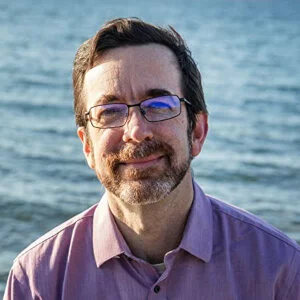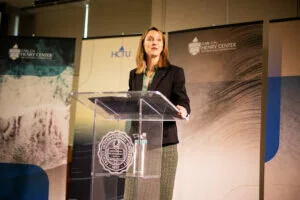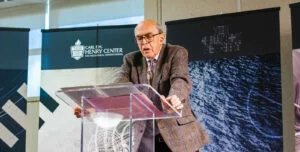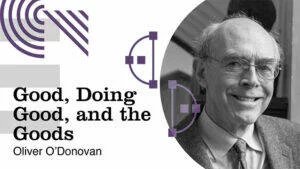As a chemist, I turn naturally to the evidence of the past that is amenable to geochemical or biochemical analysis, and integrate that with other lines of evidence. This evidence tells a story with order and even direction.
Geology, Biology, and the Story of Data
The rocks give a timeline showing how the environmental chemistry of the planet has changed radically over billions of years. In the oldest layers, geologists detect rocks that can’t exist in today’s world with its high oxygen levels: rounded, previously exposed pebbles of iron pyrite and uranium. Those rocks went away as time elapsed, and then, we detect rust-orange iron-oxygen compounds worldwide, called “Banded Iron Formations.” These formations tell a story with a direction: the oldest earth was oxygen-free, then oxygen filled the air and reacted with the rocks. Eventually, after the rocks had reacted, oxygen could fill the ocean. The geologist Robert Hazen has threaded these data into a story of “mineral evolution” over time in his book The Story of Earth.Robert Hazen, The Story of Earth: The First 4.5 Billion Years, from Stardust to Living Planet (New York: Penguin, 2013).
These pieces of data from the geological environment coincide with other pieces of biological data, which show that oxygen can increase biochemical complexity. In old genes, at the time of the first great oxygen increase, DNA sequencing detects a burst of newly invented oxygen-using genes.Lawrence A. David and Eric J. Alm, “Rapid Evolutionary Innovation During an Archaean Genetic Expansion,” Nature, 469 (2011), 93-96. Biochemical models project that oxygen metabolism allows the most complex biochemical networks, so that increased oxygen supports increased metabolic complexity.Jason Raymond and Daniel Segrè, “The Effect of Oxygen on Biochemical Networks and the Evolution of Complex Life,” Science, 311 (2006), 1764-67. In the presence of oxygen, life could build more complex things.
Geologists detect a second spate of Banded Iron Formations that happened two billion years after the first, giving evidence for a second great oxygen increase. Soon after those rocks were formed, the first complex fossils appear, in a burst of biological creativity so intense that it’s called the “Cambrian Explosion.” Several lines of evidence suggest that these geological and biological observations can be connected, and that they tell a story, in which a second increase in environmental oxygen gave life the energy and chemistry it needed to increase in complexity.
We have detected these data and many more with scientific instruments and techniques that analyze the chemistry of rocks and genes. The more data points we detect, the more those points seem to connect and to tell a coherent story that interweaves biology, chemistry, and geology.
Once enough data are collected, the question becomes whether the story being told about the data is true—that is, whether the story is something real that we are uncovering, or merely a collection of arbitrary dots connected by imaginary lines like so many constellations.
I think that the story hinted at by the geological and biological data is true—not because a “purpose” molecule was detected, or because unexplainable gaps require an undetectably complex intervention, but because of the data that are visible to all, which have been detected. Published and peer-reviewed data tell a story with direction, and therefore with purpose and a deep design.
An important difference between my view and those in the Intelligent Design community is that I think that the data we can detect tell a story of God’s activity, as our minds interpret that data to see a natural design. That design was done with divine faithfulness, integrity, and simplicity, using the same laws that we can detect and understand today, so that we can understand the consistent processes that brought us here and use them for good or for evil.
The direction that points to design is not found in irreducibly complex proteins or perfectly functional genes, but in messy, imperfect biology that nonetheless builds itself up and adapts to an ever-changing environment through natural selection and evolutionary change. In this way, beautiful things are made from the dust.
The Possibility of Purpose
I tell the story of the chemical order detected in the processes of evolution in A World from Dust: How the Periodic Table Shaped Life.Ben McFarland, A World from Dust: How the Periodic Table Shaped Life (Oxford: Oxford University Press, 2016). The pages of that book are saturated with purpose, yet I use the word “purpose” less than once per chapter (I’ve counted). Pictures, not words, point to the purpose, for those with eyes to see and ears to hear, with repeated images of arrows.
The arrows come from predictable chemical changes of the environment in the figures of A World from Dust:
- An arrow through the sky = decreasing hydrogen and increasing oxygen levels in the atmosphere over time.
- An arrow through the ocean = increased oxygen and increasing pH levels in the ocean over time.
- An arrow of oxygen vs. sulfur metabolism = microbial life self-organizes in sediments when oxygen is present, placing oxygen-using layers on the top and sulfur-using layers on the bottom (this can be seen in the microbiological experiment called a Winogradsky column).
- A second arrow through the ocean = oxygen levels change the levels of oxygen-sensitive metal nutrients in the ocean, following a predictable sequence.
- An arrow of energy = a measure called “energy rate density” tends to increase over time so that processes become more energy-intensive and therefore more complex.
Each of these arrows is an interpretation of data in which I have connected the dots with chemistry, and in which I have seen an arrow pointing in a particular direction overThere will always be a step when you have to decide how you will connect the chemical dots. time, so that life itself is ordered by these lawlike chemical trends, oriented like a compass pointing north, organized into a comprehensible story.
Because purpose is not a chemically detectable category, there will always be a step when you have to decide how you will connect the chemical dots. Therefore, you will always be able to dismiss the story of purpose as artificial, trivial, or unknowable. Even so, you will always feel the need for a story in the bottom of your heart. Is that need real or illusory? Your choice.
The essential process of connecting the dots and seeing purpose is called faith. Herbert McCabe wrote about seeing faith in historical events, and his words also apply to events in natural history:
The theologian says that faith is a sharing in God’s self-knowledge and we begin to know God by looking at his plan for human history through God’s eyes. Faith is essentially a matter of recognizing certain historical events as part of God’s plan of redemption, and of interpreting them correctly in terms of our salvation . . . There may be what Newman called ‘converging probabilities’ arguments which, while not absolutely convincing, not making the truth manifestly and certainly clear, yet point towards it.Herbert McCabe, Faith within Reason (New York: Bloomsbury Academic, 2007), 7.
Biological evolution has a reputation for supporting a faith-less view of a universe devoid of purpose — but even in this area, Newman’s convergences can be found:
- Simon Conway Morris describes biological evolutionary convergence in books such as The Runes of Evolution.Simon Conway Morris, The Runes of Evolution: How the Universe Became Self-Aware (West Conshohocken: Templeton, 2015).
- Eric Chaisson has detected a direction in what he calls Energy Rate Density (watts per unit of mass), which suggests that increasing complexity can be consistent with the laws of thermodynamics in an open, dissipative systems.Eric Chaisson, Epic of Evolution: Seven Ages of the Cosmos (New York: Columbia University Press, 2007).
- Jeff Schloss gives examples of biological predictability and direction (like metabolic scaling trends) that are strong enough to be called biological laws.See Jeffrey Schloss, “Evolutionary Biology and the Spirit” at https://www.youtube.com/watch?v=5fJIPJBX7JM (2012); see also Geoffrey B. West, James H. Brown, and Brian J. Enquist, “A General Model for the Origin of Allometric Scaling Laws in Biology,” Science, 276 (1997), 122-126.
- Denis Lamoureux asserts a “teleological” or goal-oriented view of evolution, in which direction could be built in to the universe, in contrast to the modern “dysteleological” assumption.Denis Lamoureux, Evolution: Scripture and Nature Say Yes! (Grand Rapids: Zondervan, 2016).
These similarities and trends are not proofs, but directional signs that point to the possibility of purpose. Directional and predictable biological trends are certainly detectable, but the question is whether these convergences run with the grain of the universe, or whether they are ghostly similarities that we project on the data. That question of predictability and repeatability is amenable to experiment and even in some cases to proof, but the question of purpose and design is inherently interpretive. It is amenable to story, to narrative, and to the choice of a rational mind.
Ordering Hearts, Minds, and Dots
Historical events can be supported by data, but is any complete historical story truly “detectable”? Can any design be proved by scientific instruments? It can only be pointed to. How about hope, faith, or love? Every instrument collects data that must be interpreted by a scientist. Science provides the dots, and even some direction, but the mind provides the interpretation connecting the dots. The mind is the detector for this story, not the scientificOrdered minds, set in an ordered creation, can detect where we came from and can project where we are going. instrument. Both the dots and the story told by the dots are meaningful.
The same God that transcends our understanding completely has made God’s creation rational and ordered, and amazingly, surprisingly comprehensible. Ordered minds, set in an ordered creation, can detect where we came from and can project where we are going. Ordered minds can consider the cost of building a tower and of joining God’s kingdom work.
An ordered creation is one we understand, and one in which we can bring order about by making and keeping promises. Robert Jenson wrote: “Promises can be made only if reality is getting someplace, that is, if it has a plotted story . . . The church must herself be a communal world in which promises are made and kept.”Robert W. Jenson, “How the World Lost Its Story,” First Things (October 1993).
The universe does not have to be perfectly ordered or functional in order to have purpose (which is good news, because it means that we don’t have to be perfect to have purpose either!). The universe needs to be consistent enough that promises can be made, and free enough that we can choose whether those promises will be kept. We do this because we follow a God who has made promises to us and has kept them. We call some of those consistent promises “the laws of nature.”
Only ordered minds in an ordered universe can create systems of science or government – and only such ordered minds can see just how much disorder and death we have needlessly introduced with those same systems. Only ordered minds in an ordered universe can detect their own purpose, and their deep need for help to accomplish that purpose.
The story of natural history shows purpose in the events that we can detect, which aligns with the cry of our hearts for such a story. As McCabe wrote:
I cannot see how my life-story can be in tune with humankind, in harmony with my environment and with nature itself, unless my environment and nature itself is musical too. My singing cannot be in harmony, or even out of harmony, with others unless they are singing too. I cannot see how the subplot that is my life can be fitting or even unfitting to the order of nature if that order is not a story too.McCabe, Faith within Reason, 46.
We need direction, purpose, and design, but it can be detected and known only through the eyes of faith. This is the faith that pieces the world together, knowing that God did the same piecing together in the past, faithful to God’s purpose for billions of years. This is the faith that transforms the old into the new by the hidden power of the cross, returning it to God’s original purpose and participating in the world’s redemption through the imitation of Christ.
This design can be detected, and the data can be connected, but only with the whole person—body, mind, and spirit. The more dots we collect with science, the more we detect our own need for a story connecting those dots. As Robert Jenson wrote, “reality is forcing the hard sciences into story form.”Robert W. Jenson, “Can We Have a Story?,” First Things (March 2000).
The story of chemical evolution is one strand of the story that gave direction to the universe, which interweaves with the story running from Exodus to Resurrection. These stories give strength to the idea that there is an arrow running through the universe, pointing to God’s future.







Comments
Be the first one to make a comment!